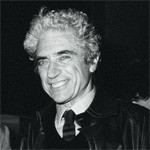An excellent tool
Jack Steinberger joined CERN in 1968 and has worked on many neutrino experiments. Together with Leon Lederman and Melvin Schwartz he received the Physics Nobel Prize in 1988 for the neutrino beam method that they developed at the Columbia University and the discovery that there are at least two kinds of neutrino.
 “Neutrinos, which are not encumbered with the complex strong interaction, provide an excellent tool to study the nucleon structure. While the SPS was still under construction, CERN therefore decided to construct a neutrino beam in which four experiments would be lined up, one behind the other. Our experiment, called CDHS for its collaborating institutions, CERN, Dortmund, Heidelberg and Saclay, was third in line.
“Neutrinos, which are not encumbered with the complex strong interaction, provide an excellent tool to study the nucleon structure. While the SPS was still under construction, CERN therefore decided to construct a neutrino beam in which four experiments would be lined up, one behind the other. Our experiment, called CDHS for its collaborating institutions, CERN, Dortmund, Heidelberg and Saclay, was third in line.
The detector had a mass of 1250 tonnes and consisted of circular iron plates in modules of 5 or 15 plates each, interspersed with detectors. Our original plan for the detector had been substantially different. It consisted of two parts, the front serving as neutrino target and particle shower measuring instrument, followed by a magnet with interspersed tracking detectors for the only penetrating particles, the muons. However, the management did not like our front part and proposed that we do this experiment combining our magnet with a part provided by another team. This was not exactly to our liking; we were not convinced of the other proposed method, and we preferred to be independent. Only then did we notice that the magnet could be transformed to do all functions simultaneously, with an overall improvement in the detector capability. I remember this as an illustration of how limited our vision is, why we did not see this in the first place, and of how bad luck can turn to one's advantage.
The CDHS detector was used at CERN from 1977 to 1983 and with the help of neutrinos a good deal could be learned about the Standard Model as well as about the structure of the nucleon. Probably the most important results of the SPS neutrino experiments was the observation of so-called ‘scaling violations’, providing a first quantitative confirmation of the new theory of the strong interaction. Although the theory was very attractive, there had been no quantitative prediction of the theory that had been confirmed. The theoretical predictions were measured by the CDHS experiment for the first time, and thus gave experimental support to the new theory, a milestone in the establishment of the Standard Model.
The beautiful present understanding of the physics of particles and their interactions is, in my opinion, one of the cultural achievements of the century just gone by, and my opportunity to participate in this was a privilege. Despite the great advance in our understanding, there are still the great mysteries, like why are the masses and interaction strengths what they are? There is no lack of unanswered, fundamental questions. But the remaining questions are more difficult than those clarified by my generation.”

